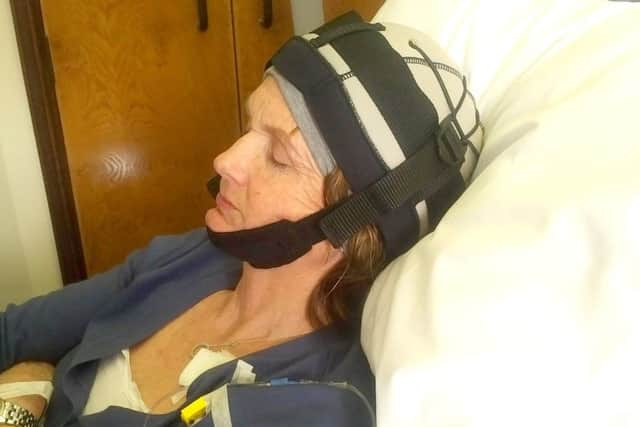'˜I didn't want cancer to take away my dignity'


But when the 49-year-old found out she would need chemotherapy, the last thing she wanted was to lose her hair.
So, along with her eldest daughter Abigail, she began to research methods she could test out to keep her locks and her dignity.
Advertisement
Hide AdAdvertisement
Hide AdThe one she decided to try was a special cooling cap – and it worked.


Now, a year after her diagnosis, mother-of-three Fiona is in remission and feeling happy and healthy – with a full head of hair.
Fiona, from Southleigh Road in Havant, discovered she had cancer after she began to feel extremely tired in January last year.
‘Before that Christmas I was absolutely shattered,’ she says.
‘I could have fallen asleep at work.


Advertisement
Hide AdAdvertisement
Hide Ad‘I’m quite a busy person. I should have listened to the signs. I was so tired, but I just put it down to being busy at work.
‘I got through Christmas and went back to work. Then my right breast started to feel different to my left breast. My mum died of breast cancer, so I went to the GP.’
The doctor couldn’t feel any lumps but, given Fiona’s concerns and her usual clean bill of health, she sent her for scans.
She went to St Richard’s Hospital in Chichester and it was there that she had a mammogram and two lumps were found.


‘I knew that day that I had cancer,’ she says.
Fiona says she thought the worst straight away.
‘I thought I was going to die,’ she says.
Advertisement
Hide AdAdvertisement
Hide Ad‘It was the worst day of my life. Everything stood still. Your whole life changes.


‘Before, you were thinking about what food you were going to buy for the weekend and then none of that matters.
‘It just blows everything away. I was having heart palpitations, it was just awful.
‘I didn’t know anything at that stage. I didn’t know what grade it was or if it had spread.’
Advertisement
Hide AdAdvertisement
Hide AdShe then had the difficult task of going home and telling her three children, Abigail, 20, Katie, 17, and Charles, 16, the devastating news.
Within a couple of weeks, Fiona had an operation to have her right breast removed.
After the operation, she was informed that the cancer had spread to her lymph nodes, which meant she needed chemotherapy.
And at that point, Fiona began her research.
‘That was when I decided that I wasn’t going to let chemo take my hair,’ she adds.
Advertisement
Hide AdAdvertisement
Hide Ad‘’I decided that I wasn’t going to allow this to take my dignity. My son, who was 15 at the time, said the only thing that frightened him was me losing my hair.’
And that was when she discovered the cap method.
The chemotherapy works by killing cells and it doesn’t distinguish between good and bad ones. It means that all your hair follicles fall out.
But the cap is frozen so the temperature stops the blood flowing to your head.
The cap fits tightly around the head and Fiona had to take paracetamol and ibuprofen to help deal with some pain.
Advertisement
Hide AdAdvertisement
Hide Ad‘It’s not used often because people don’t tolerate it, but I had hypnotherapy for it,’ Fiona says.
‘My oncologist said she had never seen such a good head of hair. ‘
Fiona had six courses of treatment lasting four hours at a time, spread over the course of three months.
She had to wear the cap for half-an-hour before the treatment and for an hour-and-a-half after.
It was so cold that she had ice in her hair.
Advertisement
Hide AdAdvertisement
Hide AdBut remarkably, she couldn’t feel the cold because of the hypnotherapy treatment she received a day before each of the sessions.
‘I found a lady in Havant called Sue Thwaites. She was so supportive and helped me through the whole process.’
Throughout her chemotherapy treatment at the Spire Portsmouth Hospital in Havant, Fiona’s husband Mark took photographs of her to document her journey.
And in June last year, she finished her chemotherapy.
‘I felt amazing,’ she says.
She went on to have radiotherapy and finished that in August. She returned to work as a school nurse in November.
Advertisement
Hide AdAdvertisement
Hide AdNow, Fiona is in remission and due for a check-up on February 14.
She is also preparing to have her left breast removed as a precaution and is due to have reconstruction surgery again, as she did for her right breast.
And now she wants other people to follow in her footsteps.
‘I don’t want people to think my hair was my first priority.
‘That was “am I going to live” and I was thinking about my family. But then I thought ‘‘I don’t want to lose my hair’’. If I had, even now it would still have been very short.
Advertisement
Hide AdAdvertisement
Hide Ad‘This all adds to the journey. Now, I walk the dog, I see other dog walkers and they wouldn’t know I had cancer because I hadn’t lost my hair.
‘People would have known otherwise. It made life more bearable.’
WHAT IS A COOLING CAP?
Fiona Whittaker used a cap made by a firm called Paxman.
The cap is constructed from lightweight, silicone tubing, which feels soft and flexible.
It moulds to the patient’s head and provides a tight yet comfortable fit during treatment.
Advertisement
Hide AdAdvertisement
Hide AdThe Paxman Scalp Cooling System is the world-leading hair loss prevention system for chemotherapy patients.
It has been used by more than 100,000 patients in 32 countries.
How does scalp cooling work?
Every hair on the body grows out of a hair follicle. Small blood vessels in the scalp supply the cells of these follicles with food and oxygen, and carry away waste products.
Any chemotherapy drugs in the bloodstream will also be carried to the hair follicles.
Advertisement
Hide AdAdvertisement
Hide AdWhen blood vessels in the scalp are cooled they become smaller, and so less blood flows through them.
Cooling the scalp during chemotherapy means that less of the chemotherapy drug reaches the hair follicles, which means the hair is less likely to fall out.
There are two widely available methods of scalp cooling. One method uses a hat known as a ‘cold cap’, which is filled with a gel that can be chilled. The hat must be fitted snugly around the head to work properly.
The other method uses a small, refrigerated cooling system to pump a liquid coolant through a cap that is attached to the cooling system.